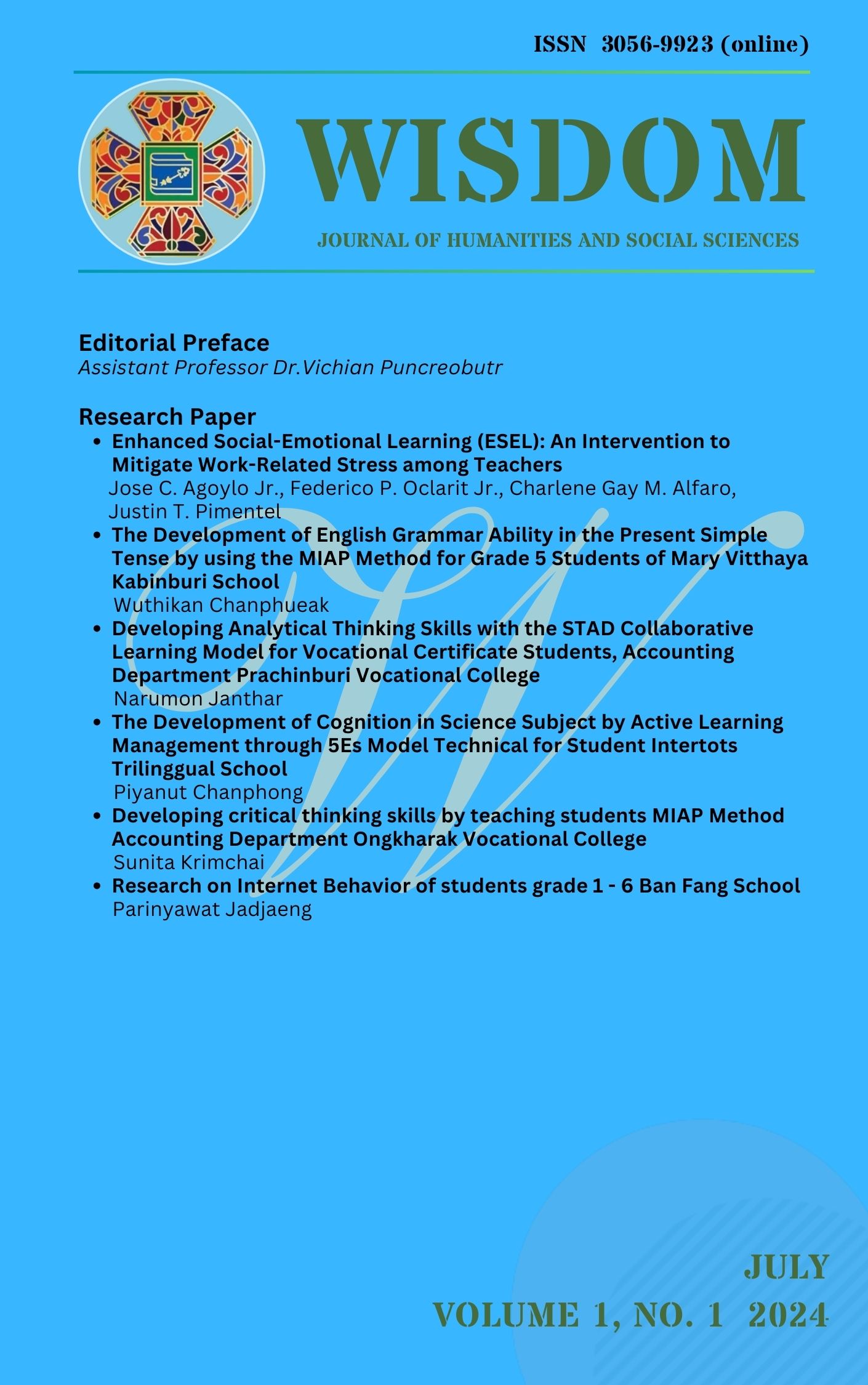The Development of Cognition in Science Subject by Active Learning Management through 5Es Model Technical for Student Intertots Trilinggual School
Keywords:
Active Learning, Technique 5Es, UnderstandingAbstract
In an analysis of Grade 6 students at Intertots Trilingual School, it was found that the mean relative developmental score was 74.35, with the highest score of 94.12 (1 student) and the lowest score of 52.38 (1 student). Furthermore, the post-test comparison revealed a statistically significant improvement at the .001 level. The efficiency of the learning management plan (E1/E2) was observed to exceed the specified threshold, indicating a high level of efficiency for the teaching lesson plan. Upon evaluation by 5 experts, the mean and standard deviation of the Appropriateness of the Management Plan by Developing Knowledge and Understanding using the 5Es Technique for Grade 6 students at Intertots Trilingual School was calculated to be 4.86. Similarly, the mean and standard deviation of student satisfaction for knowledge and understanding development in science subjects through the 5Es Model Technique for Grade 6 students at Intertots Trilingual School was determined to be 4.88.
References
ภาษาไทย
กิติมา ปรีดีดิลก. (2520). ปรัชญาการศึกษา. กรุงเทพฯ: ประเสริฐการพิมพ์.
ทิศนา แขมมณี. (2553). ศาสตร์การสอน: องค์ความรู้เพื่อการจัดกระบวนการเรียนรู้ที่มีประสิทธิภาพ. (พิมพ์ครั้งที่13). กรุงเทพฯ: สุทธาการพิมพ์.
พงศ์เทพ จิระโร (2566). เอกสารคำสอน วิชาการวิจัยเพื่อการพัฒนาการเรียนรู้ Research for Learning Development. คณะศึกษาศาสตร์ วิทยาลัยนานาชาติเซนต์เทเรซา
ภพ เลาหไพบูลย์. (2542). แนวการสอนวิทยาศาสตร์ (ฉบับปรับปรุง พิมพ์ครั้งที่ 3). กรุงเทพฯ: โรงพิมพ์ไทยวัฒนาพานิช.
รสิตา รักสกุล. (2557). สัมฤทธิผลของการจัดการเรียนการสอนแบบบูรณาการ โดยใช้ Active Learning ของนักศึกษาในรายวิชาการบริหารจัดการยุคใหม่และภาวะผู้นำมหาวิทยาลัยเทคโนโลยีพระจอมเกล้าธนบุรี. รายงานการประชุม การประชุมวิชาการระดับชาติ (1325 - 1333). มหาวิทยาลัยรังสิต.
ราชบัณฑิต.(2542). พจนานุกรมฉบับราชบัณฑิตยสถาน พ.ศ. 2542. กรุงเทพฯ: นานมีบุคส์ พับลิเคชั่น.
ศิพล รื่นใจชน. (2549). ความรู้ความเข้าใจในสิทธิของประชาชนเกี่ยวกับธุรกิจเช่าซื้อรถยนต์และรถจักรยายนต์ศึกษากรณี ประชาชนหมู่ 1 ตำบลท่ามะขาม อำเภอเมือง จังหวัดกาญจนบุรี. (วิทยานิพนธ์ปริญญามหาบัณฑิต สาขาการบัญชี). บัณฑิตวิทยาลัย มหาวิทยาลัยบูรพา.
สุมิตตา พูลสุขเสริม. (2559). การพัฒนาผลสัมฤทธิ์ทางการเรียนและพฤติกรรมการเรียนรู้โดยการจัดการเรียนรู้แบบเชิงรุก (active learning) ของผู้เรียนระดับชั้นประกาศนียบัตรวิชาชีพปีที่ 3 สาขาวิชาการตลาดวิทยาลัยอาชีวศึกษาสันติราษฎร์ ในพระอุปถัมภ์ฯ. กรุงเทพฯ: วิทยาลัยอาชีวศึกษาสันติราษฎร์ ในพระอุปถัมภ์ฯ
สำนักงานราชบัณฑิตยสภา. (2558). พจนานุกรมศัพท์ศึกษาศาสตร์ร่วมสมัย ฉบับราชบัณฑิตยสถาน.ราชบัณฑิตยสถาน. กรุงเทพฯ: สำนักงานราชบัณฑิตยสภา.
อับดุลเลาะ อูมาร์ ณัฐินี โมพันธุ์ อาฟีฟี ลาเต๊ะ และอุสมาน สารี. (2562). ผลของการจัดการเรียนรู้แบบสืบเสาะหาความรู้ (5Es) เรื่องสมดุลเคมี ที่มีต่อแบบจำลองทางความคิด ผลสัมฤทธิ์ทางการเรียนและความพึงพอใจของนักเรียนชั้นมัธยมศึกษาปีที่ 5. วารสารศึกษาศาสตร์ มหาวิทยาลัยสงขลานครินทร์. 30(1), 181-194.
English
Abdulloh Umar, Natthinee Mophan, Afifi Lateh, & Usman Sari. (2019). The effects of inquiry-based learning (5Es) on chemical equilibrium concepts, learning achievement, and satisfaction of Grade 11 students. Journal of Education, Prince of Songkla University, 30(1), 181-194. [In Thai]
Department of the Royal Academy. (1999). Royal Institute Dictionary B.E. 2542 (1999). Bangkok: Nanmee Books Publications.
Department of the Royal Academy. (2015). Contemporary Educational Terminology Dictionary, Royal Institute Edition. Bangkok: Office of the Royal Society.
Gitima Preedidilok. (1977). Philosophy of Education. Bangkok: Prasert Printing.
Phongthep Jiraro. (2023). Lecture Notes on Research for Learning Development. Faculty of Education, St. Theresa International College. [In Thai]
Phop Laohapaiboon. (1999). Science Teaching Methods (Revised Edition, 3rd Printing). Bangkok: Thai Watthana Phanit Printing House.
Rasita Raksakul. (2014). Effectiveness of integrated learning management using active learning among students in Modern Management and Leadership courses at King Mongkut’s University of Technology Thonburi. Proceedings of the National Academic Conference, 1325 - 1333. Rangsit University. [In Thai]
Sipon Ruenjaichon. (2006). Knowledge and understanding of people's rights regarding automobile and motorcycle hire-purchase businesses: A case study of Moo 1 residents, Tha Makham Subdistrict, Mueang District, Kanchanaburi Province. (Master’s Thesis in Accounting). Graduate School, Burapha University. [In Thai]
Sumitta Phulsuksom. (2016). The development of learning achievement and learning behavior through active learning management of third-year vocational certificate students in the Marketing Program, Santirat Vocational College under Royal Patronage. Bangkok: Santirat Vocational College under Royal Patronage. [In Thai]
Tissana Khammani. (2010). The Science of Teaching: Knowledge for Effective Learning Process Management (13th edition). Bangkok: Sutha Printing. [In Thai]





